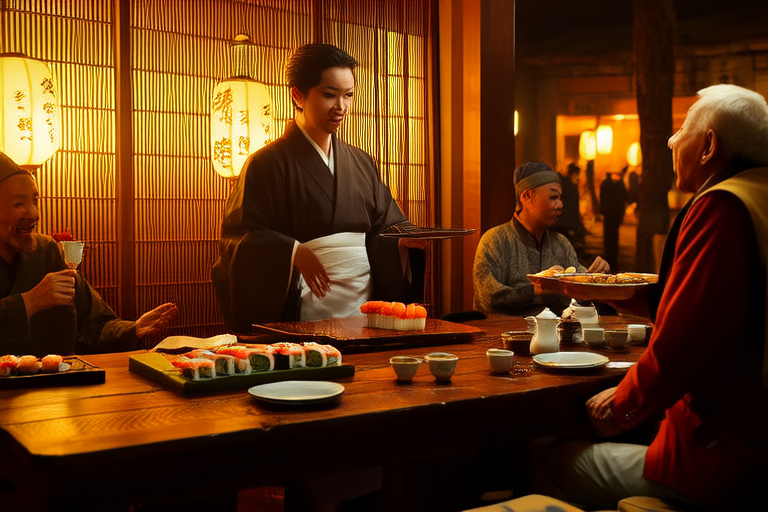Dining Etiquette: A Journey into Global Cultural Customs

Dining Etiquette: A Journey into Global Cultural Customs
Introduction
Dining etiquette refers to the set of guidelines and customs that govern behavior during meals. These rules vary widely across cultures and are deeply rooted in local traditions, reflecting the values and social structures of each society. Understanding global dining customs is crucial for travelers, as it fosters respect and appreciation for diverse cultural practices. This article explores dining etiquette from various regions around the world, highlighting both similarities and differences.
Section 1: Asia
China
In Chinese culture, dining etiquette emphasizes hierarchy and the role of the host. It is customary for the most senior guest to be seated first, and the host typically serves the guests before themselves. Chopsticks are used for eating, and it is considered impolite to point them at others or leave them sticking upright in the rice.
Japan
Japanese dining customs are marked by precision and respect. Sushi is served with care, and diners should eat it in one bite if possible. Chopstick etiquette is strict; never pass food directly from one set of chopsticks to another, as this mimics funeral rites. It is also important to wait for everyone to be served before beginning to eat.
Korea
Korean table manners include sharing dishes, which are placed in the center of the table. Elders are respected, and younger guests should wait until they are invited to start eating. It is customary to use chopsticks or spoons, and bowls should be lifted close to the mouth when eating soup.
Section 2: Europe
France
French dining is formal and often involves multiple courses. Conversation is encouraged, and wine plays a central role. Guests should not begin eating until everyone is served, and it is polite to compliment the chef or host on the meal.
Italy
Italian meals are family-oriented, with pasta being a staple. Bread is an essential part of the meal, and it is customary to break it yourself rather than passing it. Italians take their time eating, savoring each bite.
Spain
Spanish dinners are often late, starting around 9 or 10 PM. Tapas are popular, and it is common to share plates. Paella is a traditional dish, and it is served family-style. It is polite to wait for the host to serve you.
Section 3: Americas
Mexico
Food plays a significant role in Mexican celebrations, and meals often involve family and friends. Tortillas are a staple, and it is customary to fold them rather than tearing them. Spicy foods are common, and guests are expected to handle the heat with grace.
Brazil
Brazilian meals are communal, with feijoada being a national dish. Fresh ingredients are highly valued, and it is customary to share dishes. Guests should wait for the host to invite them to begin eating.
North America
North American dining is generally more informal, with fast food being prevalent. Tipping is customary in restaurants, and it is expected that servers receive about 15-20% of the bill. It is polite to show gratitude for the service.
Section 4: Africa and Middle East
Egypt
Hospitality is paramount in Egyptian culture. Tea is commonly served, and it is customary to accept it even if you do not drink it. During Ramadan, fasting is observed during daylight hours, and meals are shared with family and friends after sunset.
Morocco
Moroccan meals are communal, with couscous being a staple. Tagines are slow-cooked dishes that are shared among guests. It is polite to use your right hand to eat, as the left hand is considered unclean.
Saudi Arabia
The host plays a central role in Saudi dining customs. Dates are often served as a snack, and coffee is a traditional beverage. It is customary to refuse the first offer of food or drink, as this allows the host to insist and show generosity.
Section 5: Australia and Oceania
Australia
Australian dining is casual, with barbecues being a popular choice. Meat pies are a common dish, and it is customary to eat them with your hands. The emphasis is on enjoying the company and the food.
New Zealand
New Zealand meals often feature seafood, and Maori traditions play a significant role. Hangi is a traditional method of cooking using heated rocks. It is polite to participate in the preparation and enjoy the communal experience.
Conclusion
Dining etiquette varies widely across the globe, reflecting the unique traditions and values of each culture. By understanding these customs, travelers can show respect and appreciation for the places they visit. Embracing cultural diversity through dining experiences enriches our understanding of the world and fosters meaningful connections with people from different backgrounds.